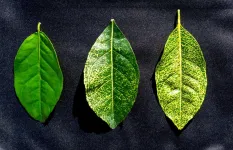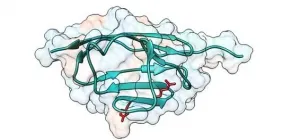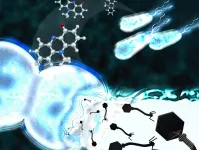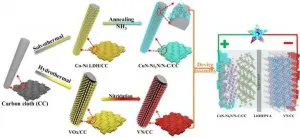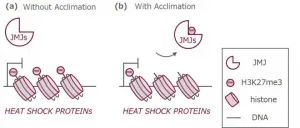(Press-News.org) LA JOLLA--(June 10, 2021) In order for cancer to grow and spread, it has to evade detection by our immune cells, particularly specialized "killer" T cells. Salk researchers led by Professor Susan Kaech have found that the environment inside tumors (the tumor microenvironment) contains an abundance of oxidized fat molecules, which, when ingested by the killer T cells, suppresses their ability to kill cancer cells. In a vicious cycle, those T cells, in need of energy, increase the level of a cellular fat transporter, CD36, that unfortunately saturates them with even more oxidized fat and further curtails their anti-tumor functions.
The discovery, published online in Immunity on June 7, 2021, suggests new pathways for safeguarding the immune system's ability to fight cancer by reducing the oxidative lipid damage in killer T cells. Identifying factors like these that cause immune suppression in the tumor microenvironment can lead to the development of novel immunotherapies for cancer.
"We know that tumors are a metabolically hostile environment for healthy cells, but elucidating which metabolic processes are altered and how this suppresses immune cell function is an important area of cancer research that is gaining a lot of attention," says Kaech, senior author and director of Salk's NOMIS Center for Immunobiology and Microbial Pathogenesis. "Our findings uncovered a novel mode of immunosuppression in tumors involving the import of oxidized fats (AKA lipids) in T cells via the cellular fat transporter CD36, which impairs their anti-tumor functions locally."
The burgeoning field of cancer immunometabolism studies how immune cell metabolism is reprogrammed within tumors and driven by alterations in nutrient availability. While scientists know that tumors accumulate fats--and that such accumulation is associated with immune dysfunction--the details of the relationship haven't been clear.
Working with Joseph Witztum's lab at UC San Diego and Antonio Pinto in the Salk Mass Spectrometry Core facility, the team established that tumors contain elevated amounts of several classes of lipid, and oxidized lipids in particular, which are generally found in oxidized low-density lipoproteins (LDLs), commonly considered "bad" fat. They then observed how killer T cells respond to the oxidized LDLs in tumors and found that killer T cells adapted to the tumor microenvironment by increasing CD36 on their surface and ingesting an abundance of oxidized lipids. Working with Brinda Emu's lab at Yale University, they found this process served as a catalyst to drive even greater amounts of lipid oxidation internally in the killer T cells and ultimately repressed their defenses.
Next, the team employed various methods to investigate how CD36 impaired killer T cell function. They created mouse models lacking CD36 on T cells and used antibodies to block CD36. They confirmed that CD36 promoted T cell dysfunction in tumors by increasing oxidized lipid import, which caused greater lipid oxidation and damage within the T cells and triggered the activation of a stress response protein, p38.
"We found that when the T cells get 'stressed out' by oxidized lipids, they shut down their anti-tumor functions," says Shihao Xu, a Salk postdoctoral fellow and the first author on the paper.
The team also found new therapeutic opportunities to reduce lipid oxidation and restore killer T cells' function in tumors through immunotherapy by blocking CD36 with an antibody therapy or by overexpressing glutathione peroxidase 4 (GPX4, a key molecule that removes oxidized lipids in cells).
Importantly, lipid oxidation doesn't just happen in T cells; it also happens in tumor cells, and too much of it can cause cell death. In fact, there is a lot of excitement in cancer research to increase lipid oxidation in tumor cells to a lethal level, but Kaech and her team urge some caution.
"Now that we've uncovered this vulnerability of T cells to lipid oxidation stress, we may need to find more selective approaches to inducing lipid oxidation in the tumor cells but not in the T cells," says Kaech, who holds the NOMIS Chair at Salk. "Otherwise, we may destroy the anti-tumor T cells in the process, and our work shows a few interesting possibilities for how to do this."
INFORMATION:
Other authors on the study were Patricia Rodríguez-Morales, Dan Chen, Ziyan Xu, Antonio F. M. Pinto, April Williams, Yagmur Farsakoglu, Siva Karthik Varanasi, Bryan McDonald, Victoria Tripple, Michael Downes, Ronald M. Evans and Maxim N. Shokhirev of Salk; Omkar Chaudhary, Jun Siong Low and Brinda Emu of Yale University; Xiaoli Sun, Wenxi Tang and Joseph L. Witztum of UC San Diego; Roberta Zappasodi, Isabell Schulze, Taha Merghoub and Jedd D. Wolchok of Memorial Sloan Kettering Cancer Center; Haiping Wang and Ping-Chih Ho of the University of Lausanne; Nada A. Abumrad of the Washington University School of Medicine; and Guoliang Cui of the German Cancer Research Center and Heidelberg University.
The work was funded by the National Cancer Institute, the James B. Pendleton Charitable Trust, the National Institutes of Health, the Chapman Foundation, the Helmsley Charitable Trust, the National Institute of General Medical Sciences, the Helmsley Center for Genomic Medicine, the Parker Institute for Cancer Immunotherapy Bridge Scholar award, the Salk Cancer Center, a NOMIS Foundation Distinguished Scientist and Scholar Award, the Lustgarten Foundation, the Don and Lorraine Freeberg Foundation, a Helmholtz Young Investigator Award, the German Research Foundation, the Melanoma Research Alliance, a Genentech Foundation Fellowship, and a Salk Innovation Grant.
About the Salk Institute for Biological Studies:
Every cure has a starting point. The Salk Institute embodies Jonas Salk's mission to dare to make dreams into reality. Its internationally renowned and award-winning scientists explore the very foundations of life, seeking new understandings in neuroscience, genetics, immunology, plant biology and more. The Institute is an independent nonprofit organization and architectural landmark: small by choice, intimate by nature and fearless in the face of any challenge. Be it cancer or Alzheimer's, aging or diabetes, Salk is where cures begin. Learn more at: salk.edu.
Scientists are hoping the RNA of an obscure infection can one day be used like a Trojan horse to deliver life-saving treatments to citrus trees.
The infection, citrus yellow vein disease, was discovered 64 years ago in Riverside and has never been seen elsewhere in the world. Decades later, UC Riverside researchers have finally unraveled the associated pathogen's genetic codes -- a significant step toward harnessing its unique properties.
A paper describing this work was published recently in the journal Frontiers in Microbiology. It opens the door to testing whether this apparently ...
Scientists at the Centro Nacional de Investigaciones Cardiovasculares (CNIC) have described a potential disease-causing mechanism in hypertrophic cardiomyopathy (HCM), the most frequent hereditary disease of the heart. The study, published in the journal ACS Nano, provides the first description of an association between this disease and mechanical alterations to a component of the contractile machinery of the heart.
The heart muscle is under constant mechanical stress throughout life as it contracts to pump blood to the body. The laboratory led by Dr. Jorge Alegre-Cebollada investigates how the mechanical properties of the cardiac proteins determine the physiological behavior of this muscle and how alterations to these properties lead to the appearance of diseases like ...
This targeted control of phages provides entirely new biotechnological and therapeutic approaches, e.g. for phage therapies. The results produced in the context of an ERC grant have been published in the Journal of the American Chemical Society.
The human body and its microbiota harbour a large amount of phages. These infect bacteria as virus particles to ensure their own survival. One of their strategies is to integrate into the bacterial genome and multiply via bacterial cell division. However, external signal molecules can trigger the phages' sudden awakening from their dormant ...
Imagine you're a fisherman living by a lake with a rowboat. Every day, you row out on the calm waters and life is good. But then your family grows, and you need more fish, so you go to the nearby river. Then, you realize you go farther and faster on the river. You can't take your little rowboat out there - it's not built for those currents. So, you learn everything you can about how rivers work and build a better boat. Life is good again...until you realize you need to go farther still, out on the ocean. But ocean rules are nothing like river rules. Now you have to learn how ocean currents work, and then ...
DARIEN, IL - Findings from a recent study show that patients with untreated, moderate to severe obstructive sleep apnea had a higher risk of experiencing a cardiovascular event, but the risk of incident heart problems was decreased in those who used CPAP therapy.
Results show that people with moderate to severe sleep apnea and no record of CPAP use were 71% more likely than those without sleep apnea to experience incident myocardial infarction, stroke, unstable angina, heart failure or cardiovascular death. Compared with the risk of heart problems in people with untreated sleep apnea, the risk of experiencing a cardiovascular event was 32% lower ...
ITHACA, N.Y. - The Noceto Vasca Votiva is a unique wood structure that was unearthed on a small hill in northern Italy in 2005. Built primarily of oak and slightly larger than a backyard swimming pool, the exact purpose of the in-ground structure has remained a mystery, as has the date of its construction. Italian researchers estimated its origins go back to the late Middle Bronze Age, sometime between 1600 and 1300 B.C.
While that gap might not seem huge, in archeological terms it's like comparing the culture that invented the steam engine with the one that produced the iPad.
A Cornell University team led by Sturt Manning, Distinguished ...
Fast radio bursts, or FRBs, blaze for a few milliseconds before vanishing without a trace. Their origins are unknown, and their appearance is unpredictable. In the decade following their discovery in 2007, only 140 FRBs had been seen. Now, thanks to the launch of a large stationary telescope in the interior of British Columbia in 2018, the number of new FRBs detected has almost quadrupled - for a total of 535. Moreover, the Canadian Hydrogen Intensity Mapping Experiment (CHIME/FRB), a McGill-led inter-university collaboration, has put together the first CHIME/FRB catalogue, which will be presented this week at the American Astronomical Society Meeting.
CHIME is unique in that ...
Recently, a research team led by Prof. ZHAO Bangchuan from the Institute of Solid Materials of the Hefei Institutes of Physical Science (HFIPS) synthesized 3D porous honeycomb-like CoN-Ni3N/N-C nanosheets and vanadium nitride (VN) nanobelt arrays via in-situ growth method, respectively, and constructed a high-energy-density flexible supercapacitor device. The result has been published in Advanced Functional Materials.
Transition metal nitrides (TMNs) are potential electrode materials for high-performance energy storage devices, but the structural instability severely hinders their application. Therefore ...
Ikoma, Japan - "If you can't stand the heat, get out of the kitchen," as the old saying goes. But for organisms that can't leave the proverbial kitchen when things get too hot, there's another way: researchers from Japan have discovered that plants can gain heat tolerance to better adapt to future heat stress, thanks to a particular mechanism for heat stress 'memory'.
In a study published in Nature Communications, researchers from Nara Institute of Science and Technology have revealed that a family of proteins that control small heat shock genes enables plants to 'remember' how to deal with heat stress.
Climate change, especially global warming, is a growing threat to agriculture ...
Prostate cancer is the most common form of cancer among Canadian men and the third leading cause of cancer death. Abdominal obesity appears to be associated with a greater risk of developing aggressive prostate cancer. This link was demonstrated in a END ...
